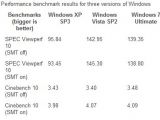Windows 7 has been receiving high praises as far as performance goes since the operating system debuted into Beta. Not even at the Beta Build 7000 level and not at Release Candidate (RC) Build 7100 was Windows 7 criticized for any sort of performance issues. On the contrary in fact, Windows 7’s new task execution speed, responsiveness, lack of hangs and freezes were applauded across the board by testers and adopters. Just imagine an operating system that is at the opposite pole compared to Windows Vista RTM, which was crucified as soon as it hit the shelves, and found to be slower than its predecessor on the same hardware. In contrast, Windows 7 has been receiving nothing but accolades performance-wise, and well-deserved accolades at that.
Microsoft managed to deliver the first official Windows Vista vs. Windows 7 performance measuring contest with a boot speed drag race back in early 2009. But startup speed is only one aspect of performance. InfoWorld’s Andrew Binstock put together a comparison of Windows 7, Vista SP2 and XP SP3 on a Dell Precision T3500 workstation (equipped with a quad-core Xeon W3540 (formerly codenamed Nehalem) CPU 2.93GHz, Nvidia FX Quadro 4800, and 4GB of RAM). Two benchmarks were used in order to compare the three operating systems, namely SPECViewperf benchmark from the Standard Performance Evaluation Corporation and CineBench from Maxon Computer.
The tests run on the Nehalem processor involved two scenarios, the first in which symmetrical multithreading (SMT) was enabled, the second in which it was not. SMT is a technology specific to the latest Intel Core microarchitectures, developed under the codename Nehalem, which makes it possible for each core to run two simultaneous threads. This means that the quad-core Xeon W3540’s can run up to eight threads simultaneously, two per core.
Windows 7’s scores were unquestionably superior to those of XP according to the results provided by the SPECViewperf and Cinebench. Of course so were Vista’s. However, users should take note that the benchmark in question involves Windows Vista Service Pack 2, a release that was made available in mid-2009, when the development process of Windows 7 was approaching the end. The highest score Windows 7 got with SPECViewperf was 139.35, much superior to XP SP3’s 95.84, but inferior to Vista SP2’s 145.30. In the Cinebench benckmark, Windows 7 got the biggest rating, 4.09, Vista SP2 was runner up with 4.07 and XP SP3 last with 3.98, considering just the highest scores the three operating systems received.
The benchmarkings indicate that the performance of Windows 7, while leaving XP SP3 in the dust, is approximately on par with Vista SP2’s. Microsoft has after all had three years to fine tune Windows Vista into the usable operating system that it is today. Fact is that if Microsoft had released Vista at SP2 and not as RTM XP’s successor would have never been compared with Windows ME.
It’s not surprising to me that there’s little to no difference between Vista SP2 and Windows 7 performance-wise, as resulted from the two benchmarks. But I think that a fair comparison would have had to involve Windows XP RTM and Windows Vista RTM, not the evolved versions of the two operating systems. And I believe that in such a scenario Windows 7’s superiority in terms of performance would have been unquestionable.
Still, users must understand that a benchmarking could be little relevant compared to using the operating system day-to-day. I have always opined that it is the users’ impression of performance and not the actual performance that in the end makes the difference.

 14 DAY TRIAL //
14 DAY TRIAL // 
